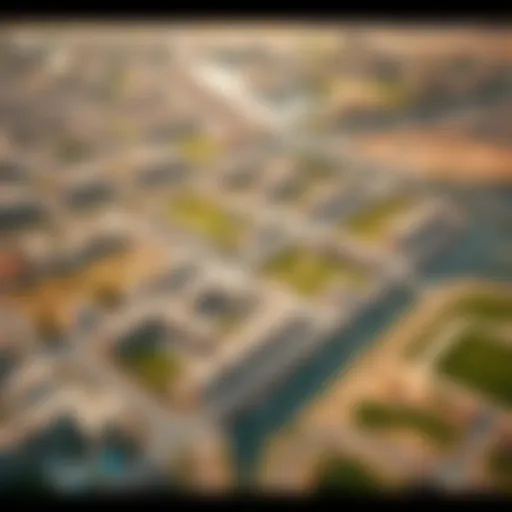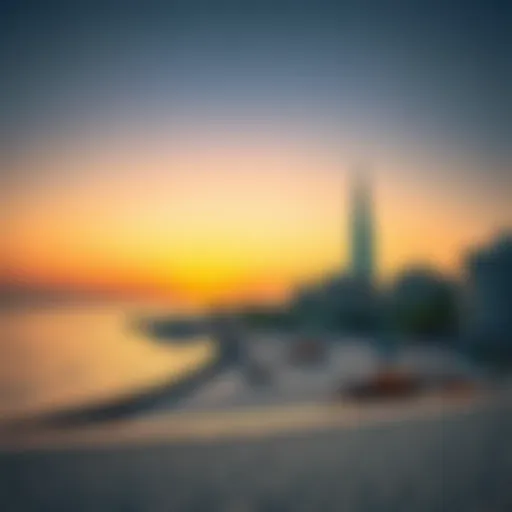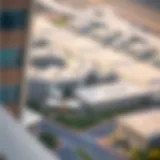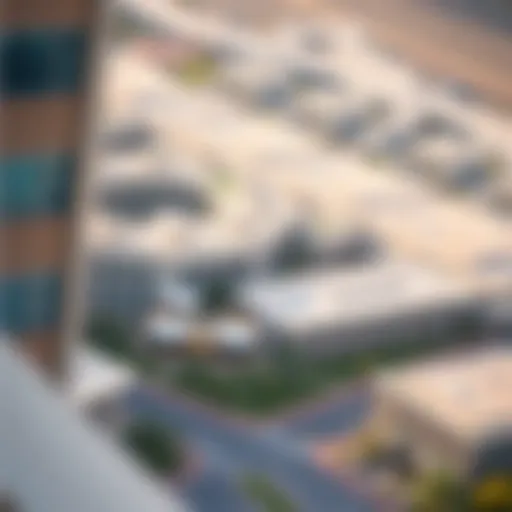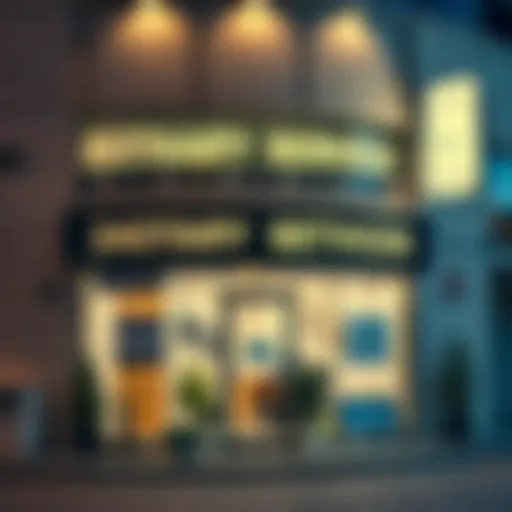Analyzing Partition Systems in Al Safa Tower
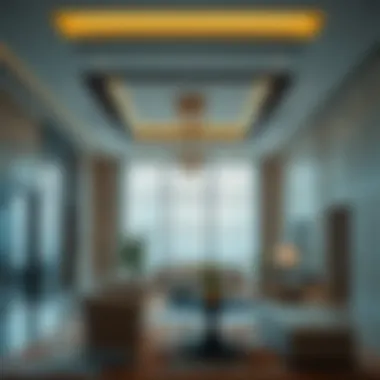
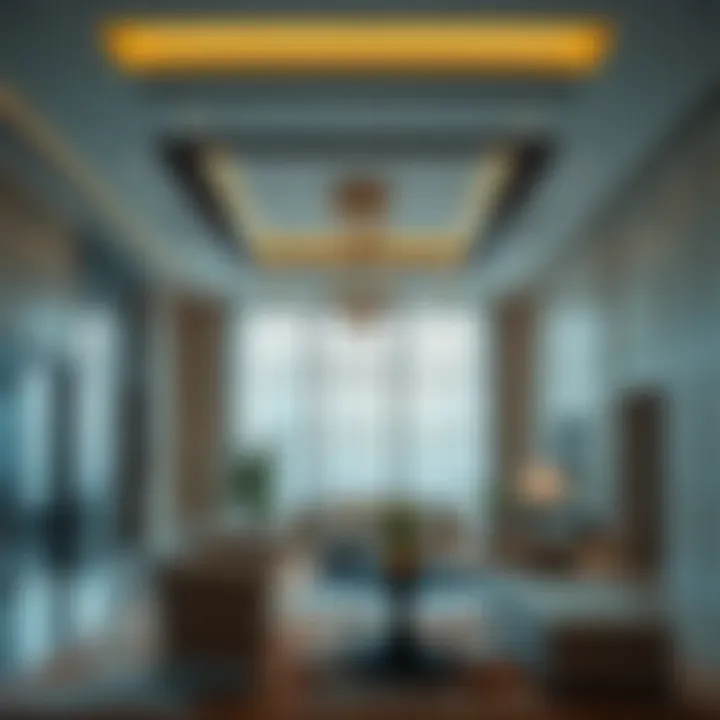
Intro
The architectural landscape of Dubai is known for its stunning skyscrapers and luxurious living spaces, but one of its most interesting facets is the role of partitions in these structures. Al Safa Tower is a prime example. This residential marvel not only provides a luxurious living experience but also highlights how partitions shape the overall functionality and aesthetic of living spaces.
As the city evolves, so too does the concept of what it means to live in a high-end residential tower. From maximizing space to creating an environment that feels both homely and sophisticated, partitions play a crucial role in achieving these goals. Understanding their design intricacies is vital not just for residents but also for investors and real estate professionals looking to navigate Dubai's dynamic property market.
Information on the types of partitions, the materials used, and their architectural significance will be thoroughly discussed. By diving into the specifics, investors, homebuyers, agents, analysts, and developers will gain valuable insights that can help inform their decisions in this competitive real estate market.
Therefore, the following sections will explore the current state of the market and delves into the partitions that make Al Safa Tower more than just another building. We will explore how these elements interplay with luxury living, space utilization, and design intent.
Prelims to Al Safa Tower
Exploring the Al Safa Tower is not just about admiring its towering presence in Dubai’s skyline; it’s about grasping the significance of its architectural design and understanding the role of partitions in optimizing luxury living. This iconic structure stands as a symbol of modernity and innovation in the heart of one of the world’s most bustling cities, offering insights into design methodologies that resonate well beyond its walls.
Overview of the Building
Completed in 2015, Al Safa Tower rises majestically to about 220 meters, easily identifiable amidst other skyscrapers in the Downtown Dubai area. It consists primarily of luxurious residential units with a mix of amenities that cater to a discerning clientele.
The architectural style reflects a blend of sophistication and contemporary aesthetic. Sleek glass facades mirror the desires of urban living—combining functionality with visual appeal. Al Safa Tower boasts state-of-the-art facilities including a swimming pool, fitness center, and communal spaces, all meticulously designed to enhance the resident experience.
In its design, there’s a thoughtful integration of partitions, intended to delineate spaces without compromising the overall openness. This aspect is crucial for both privacy and communal interactions, allowing residents to customize their living environments to fit their lifestyles. Residents often appreciate how these partitions contribute to their sense of home, crafting spaces that feel both expansive and intimate when required.
Significance in Dubai's Skyline
The inclusion of Al Safa Tower in Dubai's skyline cannot be overstated. Over the years, the tower has become not just a residential choice but a landmark illustrating Dubai's commitment to architectural excellence. It stands shoulder to shoulder with other iconic structures, yet it brings a unique character that resonates strongly with those who inhabit it.
The tower's visibility from various points in the city adds to its significance; as one strolls along the waterfront of the Dubai Canal, Al Safa Tower emerges as a testament to modern design and engineering. Its innovative use of partitioning strategies highlights a commitment to enhancing living experiences in urban environments, establishing standards for future structures.
In summary, Al Safa Tower isn’t merely a building; it’s an embodiment of design philosophy that marries luxury with practicality. The partitions within not only serve a functional purpose but also redefine how space can be experienced in luxury living. It invites potential investors and residents to consider what the modern lifestyle in Dubai may look like, wrapped in elegance and utility.
Understanding Partitions
In the context of Al Safa Tower, the concept of partitions runs deeper than mere walls dividing spaces. They play a pivotal role in the overall functionality, user experience, and even the aesthetic appeal of a living environment. Partitions are crucial for delineating spaces, leading to better organization while impacting how residents interact within their homes. For real estate investors and homeowners alike, understanding partitions means comprehension of how these structures contribute to the luxury living experience that Al Safa is renowned for.
Benefits and Considerations of Understanding Partitions
When builders invest in high-quality partitions, they focus not only on physical separation but also on how these separations manage sound, light, and privacy. A thoughtful partition system can influence everything from how much light seeps into a living space, to how individuals feel their personal areas are respected. Here are a few key elements to consider:
- Functionality: Partitions create different zones for distinct purposes. Be it a home office, a children's play area, or a relaxation nook, these subdivisions can elevate the usability of a given space.
- Aesthetic Appeal: Well-designed partitions can enhance the overall look of a space. Whether it’s through smart layout designs or meticulous material choices, partitions often contribute to the visual narrative of an interior.
- Sound Management: Soundproofing features in partition designs can minimize distractions from neighbors, allowing residents to enjoy a peaceful environment.
- Flexibility: With modular partitions, spaces can evolve based on the needs of the occupants. This adaptability is particularly valued in urban settings where every square foot counts.
Definition and Purpose
At its core, a partition is any physical divider that separates spaces within a structure. This can range from solid walls to movable screens. The term encompasses a variety of systems that serve to create boundaries, enhance privacy, and allow for better space management. In a luxury apartment tower, such as Al Safa, partitions are also about sophistication and style. They are integral in defining how spaces are perceived and utilized. For example, instead of simply enclosing a room, thoughtfully arranged partitions can offer an engaging organization of space.
"The right partition can transform a chaotic space into a serene environment, tailoring a home’s atmosphere to the degree of comfort and privacy one desires."
Types of Partitions
When discussing partitions, it’s essential to explore the different types utilized in residential designs, each bringing its own flavor to space. Below are some common varieties found within Al Safa Tower, alongside their unique features and advantages:
- Fixed Partitions: These are traditional walls that do not move. They provide strong privacy and sound isolation but lack flexibility.
- Movable Partitions: Ideal for multifunctional spaces, these allow residents to adjust their environment based on current needs. They often slide or fold and can significantly transform the area.
- Glass Partitions: Emphasizing openness while still providing separation, glass partitions offer a modern touch. They can create barriers without completely shutting out light or views, making them perfect for spaces that require both openness and division.
- Half-walls and Screens: These designs enhance airflow and visibility while still maintaining some level of division. Often decorative, they serve both functional and aesthetic roles.
Understanding the different types of partitions and their respective advantages helps anyone from investors to future residents appreciate how these elements contribute to the overall living experience in Al Safa Tower.
Architectural Design of Al Safa Tower
The architectural design of Al Safa Tower encapsulates the spirit of modernity and functionality, distinctly contributing to Dubai’s illustrious skyline. In this towering entity, the integration of partitions plays a vital role not just in demarcating spaces, but in defining the overall aesthetic and livability of the building. Precision in architectural intent directly translates to how residents interact with their environment.
To make the most of limited urban space, every inch matters. This necessity for efficient use drives the decisions regarding partitioning systems. With an eye towards luxury living, the architectural design of Al Safa Tower reflects a commitment to both form and function. It sets the stage for a harmonious living experience where comfort and style converge.
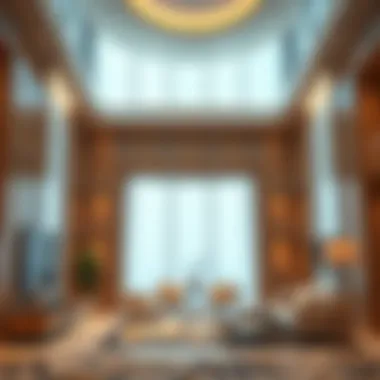
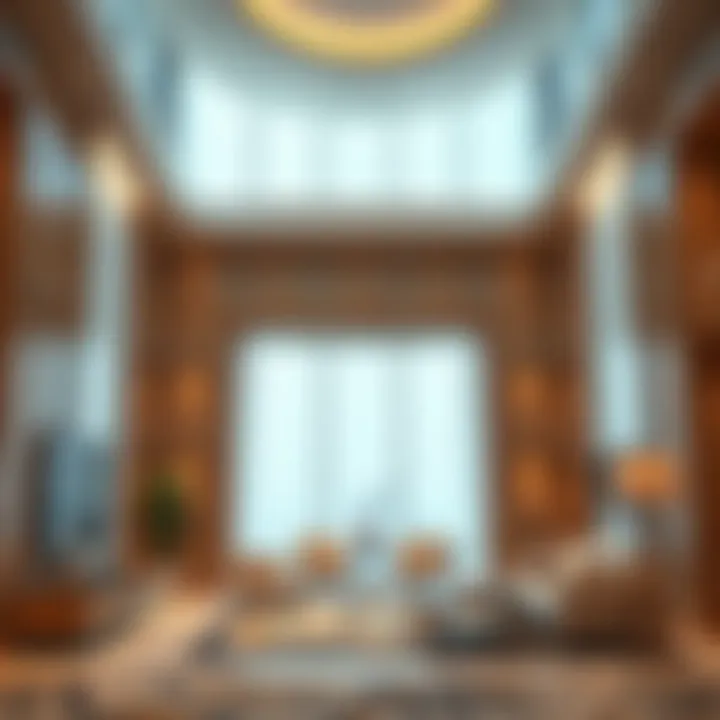
Architectural Intent Behind Partitions
The architectural intent behind the partitions in Al Safa Tower can be likened to a composer crafting a symphony — each element must be finely tuned to achieve a cohesive, pleasing harmony. Architects consider both aesthetic appeal and functional requirements when designing these interior dividers. By using innovative layouts, they aim to foster community while ensuring privacy.
In residential designs, it's vital to create environments that breathe and flow. For instance, glass partitions not only allow light to flood into spaces but also create a sense of openness, making areas feel more expansive. Conversely, solid wall partitions provide essential privacy in personal areas. This nuanced balance reflects the architect’s strategy of enhancing user experience. Layouts are meticulously planned to allow for optimal interaction among residents while keeping personal sanctuaries intact.
Architects also emphasize sustainable materials in partition design, working towards minimizing environmental impact while embracing cutting-edge technology. Embodying the spirit of Dubai's rapid urban advancement, partitions in Al Safa Tower serve as both design statements and functional barriers, carefully crafted to manage sound and light while contributing to energy efficiency.
Impact of Partitions on Flow and Functionality
The impact of partitions on flow and functionality in Al Safa Tower is substantial, akin to the arteries in a body—fundamental to its health and overall performance. Effective partitioning contributes to the seamless movement within the building, guiding users through various spaces while still allowing for individual comfort.
- Space Utilization: Partitions effectively delineate boundaries in open areas, enhancing usability in communal settings such as lounges and shared kitchens.
- Resonance of Design: Thoughtful placement of partitions can minimize noise disturbances, thus enhancing the tranquility essential for a luxurious living experience.
- Adaptability: Modular partition systems enable transformation, allowing spaces to be reconfigured as user needs change, catering to diverse lifestyles from small families to larger gatherings.
The careful introduction of niches and alcoves through strategic partition placement not only optimizes space but also encourages natural social interaction. This ability to balance private retreat with communal engagement ultimately contributes to the much-desired sense of belonging within a modern urban residence.
"Architectural partitions in Al Safa Tower exemplify how carefully designed spaces can foster a unique, enriching living experience."
Overall, the architectural design of Al Safa Tower underlines a profound understanding of where luxury meets practicality, showcasing how thoughtful partitioning is integral to both aesthetic appeal and everyday function.
Materials Utilized in Partitioning
In the grand scheme of architecture, the role of materials in partitioning cannot be overstated. These materials dictate not just the aesthetic appeal but also the functionality and sustainability of spaces within structures like Al Safa Tower. Using the right materials in partitioning creates a balance between durability and elegance, ensuring spaces remain both visually captivating and practical. In this section, we will delve into the common materials used in the tower's partitions as well as the sustainability considerations that play an increasingly crucial role in modern construction.
Common Materials in Use
When it comes to partitioning in Al Safa Tower, a variety of materials have come into play, each offering distinct advantages. These materials contribute significantly to the tower's identity and performance. Here are some of the most commonly utilized materials:
- Gypsum Board: Widely known for its lightweight and flexible nature, gypsum board is favored for creating partition walls due to its quick installation and cost-effectiveness.
- Glass Panels: These allow for abundant natural light and create a sense of openness while simultaneously maintaining a degree of privacy. They serve well in communal areas, enhancing the building's visual sophistication.
- Wooden Frames: Offering an organic touch to the modern aesthetic, wooden frames can be installed within partitions to add warmth and a personalized feel to different spaces.
- Metal Structures: Utilizing steel and aluminum, these materials provide structural integrity and durability. They're particularly effective in high-traffic areas where resilience is paramount.
The careful selection of these materials results in an interactive balance of light, sound, and fluidity throughout the living spaces in Al Safa Tower.
Sustainability Considerations
As the world becomes increasingly aware of sustainable practices, the materials used in partitioning must meet rigorous environmental standards. Sustainability is not merely a trend but a critical focus in Dubai's real estate landscape. Here’s how sustainability is considered in the partitioning materials of Al Safa Tower:
- Recyclability: Many partition materials chosen for the Tower are recyclable. For instance, gypsum can be broken down and reused in the production of new building materials.
- Energy Efficiency: Some materials, such as thermal insulation panels, contribute to energy efficiency by reducing heating and cooling loads. This not only lowers the carbon footprint but also results in cost savings for residents over time.
- Low VOC Emissions: The choice of adhesives and finishes with low volatile organic compound emissions is crucial. This leads to healthier indoor air quality, an essential aspect of creating livable spaces for residents.
In summary, understanding materials utilized in partitioning isn’t just about knowing what goes into the walls but about grasping how these choices impact lives, the environment, and the overall architectural narrative of Al Safa Tower.
"Choosing the right materials is more than aesthetic; it’s about building a legacy that echoes sustainable living in every aspect."
Through thoughtful design and material utilization, Al Safa Tower stands as a testament to modern architectural principles that value not just beauty but also the longevity and sustainability of urban living.
For more insights on sustainable architecture, visit Wikipedia or check out Britannica for comprehensive overviews.
Interior Layout Implications
Effects on Space Utilization
The design of any residential structure plays a crucial role in how space is utilized. For Al Safa Tower, thoughtful partitioning is not merely a matter of aesthetics; it’s about maximizing the functionality of each square foot. When partitions are strategically placed, they define spaces without overwhelming the area.
In Al Safa Tower, the use of light, movable partitions allows residents to adapt their living spaces to their needs. For instance, a flexible setup in the living area can transform a cozy space for small gatherings into a more open area for larger social events. This versatility is one of the many benefits that partitions provide.
Moreover, the way space is utilized can affect the overall atmosphere of a home. Unlike fixed, bulky walls, partitions can create zones of activity while preserving an overall sense of openness. This also ensures better airflow and natural light distribution, contributing to the well-being of residents.
- Enhanced functionality: Space becomes multifunctional, catering to various activities.
- Improved air circulation: Open designs lead to a fresher environment.
- Natural light access: Every corner benefits from sunlight, reducing the need for artificial illumination.
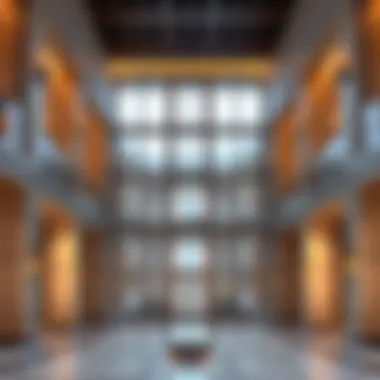
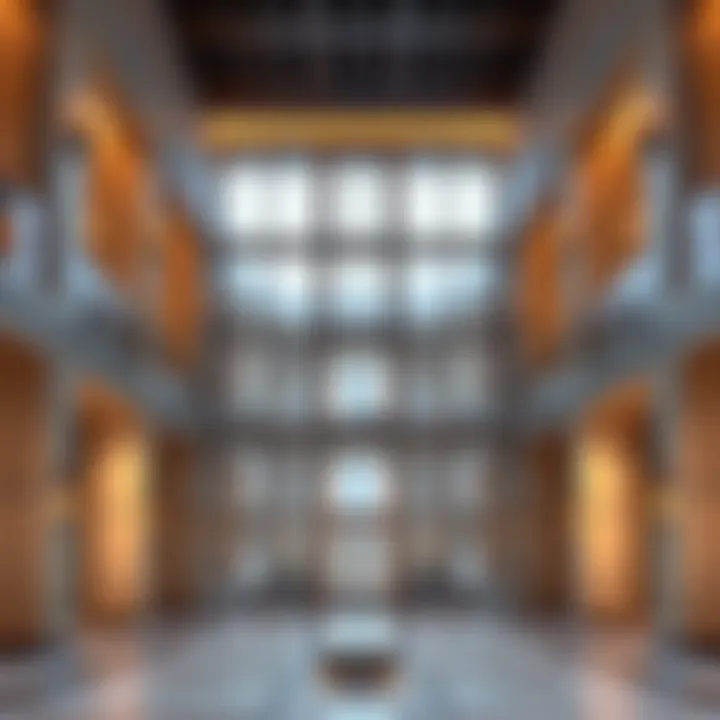
Such design choices indicate that users can maintain their desired privacy while still feeling connected to the larger space around them.
Balancing Privacy and Openness
In today’s urban living landscape, the need for privacy is as essential as the desire for openness. Al Safa Tower has successfully navigated this tightrope by incorporating partitions that provide a sense of seclusion without isolating individuals.
The partitions in each apartment are deliberately designed to offer both benefits. For example, bedrooms are strategically placed to ensure that personal spaces are distanced from communal areas, fostering a sanctuary-like feel. This layout supports comfortable living while allowing family members or roommates to coexist without stepping on one another's toes.
On the opposite side of the spectrum, shared spaces such as kitchens and living rooms are typically designed to be more open. This encourages interaction and communal engagement, vital for building relationships in a residential setting. Such design can be elevating.
"The best living environments are those that allow privacy when needed, yet promote a sense of community and connection."
The balance is further enhanced through the choice of materials and finishes on partition walls. Utilizing transparent materials, such as glass, creates the illusion of openness while still providing a necessary boundary. This approach cleverly incorporates aesthetics with practicality, which is a hallmark of Al Safa Tower’s design philosophy.
In summary, the interplay between privacy and openness in the interior layout of Al Safa Tower showcases the forward-thinking design intended to enhance the living experience for its residents. By carefully considering the implications of space utilization through partitions, the tower stands as a model for future developments in urban residential architecture.
User Experience in Al Safa Tower
The user experience within the Al Safa Tower is crucial, as it not only influences residents' day-to-day interactions with their living environment but also shapes their overall satisfaction and perception of luxury living. This aspect is particularly significant in a city like Dubai, where residents expect a harmonious blend of style, comfort, and functionality. In understanding user experience, we consider how architectural choices—especially concerning partitions—affect both physical space and emotional responses.
Resident Feedback on Partition Layout
Understanding the residents' feedback on the partition layout offers invaluable insights into how these architectural decisions impact everyday life. Many residents have expressed that the layout, which includes various partition types, significantly enhances privacy while promoting openness in communal areas. This delicate balance is essential in residential towers, where individuals desire both personal sanctuary and social interaction.
An interesting aspect of the feedback has been the emphasis on flexibility—residents appreciate features such as movable partitions. These elements allow for customization of spaces based on individual needs or preferences, which can range from needing a quiet home office to hosting gatherings without feeling cramped. Positive feedback often highlights how well the design accommodates different lifestyles, which is vital in a diverse community like that of Dubai.
An example might be a family with children who find the ability to create an open play area invaluable, while at the same time having the option to close off certain sections for dedicated work or study time. Thus, the partition design truly becomes a facilitator of lifestyle enhancements rather than merely a structural feature.
"Living in Al Safa Tower feels like having my cake and eating it too! The partitions let me maintain my personal space, but I can easily transform my home for entertaining."
This adaptability fosters a sense of satisfaction among residents. The feedback indicates that when residents feel empowered to modify their living space, they develop a stronger emotional connection to their home. This connection is essential in enhancing user experience, making the apartment feel uniquely theirs.
Psychological Effects of Partition Design
When discussing the psychological effects of partition design within Al Safa Tower, it’s necessary to consider both perceived and real impacts on residents' well-being. The use of partitions plays a role not just in practicality but also in how individuals feel about their space. For instance, strategic partition placements and designs can foster a sense of security and comfort, crucial in urban environments that might sometimes feel chaotic.
Research indicates that having clear boundaries can reduce stress levels. In Al Safa Tower, the partitions contribute to creating zones that define living spaces. This zoning is particularly beneficial in shared dwellings, where residents can retreat to their personal areas, allowing for moments of solitude amidst a potentially bustling home life.
Moreover, the choice of materials and the aesthetics involved in partitions directly influence how light transitions through spaces, creating an atmosphere that can either uplift or overwhelm. Residents have reported that well-thought-out designs bring in natural light, enhancing mood and productivity. Therefore, effective partition design becomes not just a functional concern but a psychological one, fostering well-being through intentional design choices.
In short, user experience in Al Safa Tower extends beyond mere walls and doors. The feedback highlights how critical partitions are in shaping lives, enhancing privacy whilst instilling a sense of openness and flexibility. The psychological ramifications echo through these design choices, influencing everything from comfort levels to overall happiness in everyday life. As such, developers and architects must take these factors into account when envisioning future designs.
Comparative Analysis with Other Towers
Exploring the landscape of modern architecture, especially in a bustling hub like Dubai, requires a close look at how different structures integrate design features such as partitions. The study of these partitions within Al Safa Tower offers vital insights beyond its own bounds, encouraging a comparative analysis with other prominent towers in the vicinity. Such analyses foster greater appreciation and understanding of design choices that transform mere buildings into landmark residences. Moreover, they spotlight unique aspects that contribute to functionality and overall aesthetic appeal.
How Al Safa Tower Stands Out
Al Safa Tower, like an artist’s masterpiece amidst a gallery of varied styles, has established a distinct place within Dubai’s skyline. One key differentiator is the innovative partition solutions that maximize living space without compromising on luxury. These partitions are not merely physical dividers; rather, they enhance the flow of light and air, creating an illusion of spaciousness even in compact layouts.
- Flexibility in Space Usage: The partitions in Al Safa Tower allow for a versatile use of space. Unlike traditional fixed walls in other towers, these adaptable designs cater to the dynamic lifestyles of the residents, providing options to modify the space as per individual preferences.
- Aesthetic Cohesion: Design elements in Al Safa Tower’s partitions complement the building’s overarching architectural theme, resulting in a cohesive visual experience. This level of integration is often lacking in competing structures, where partitions can appear as afterthoughts rather than essential elements of design.
- Sustainability and Materials: Al Safa Tower’s choice of sustainable materials for its partitions speaks to a growing trend among luxury buildings. This commitment to eco-friendliness is a notable facet that distinguishes it from other local towers, many of which still rely on conventional building techniques that may not prioritize sustainability.
Lessons from Competing Structures
In every tower there are lessons to be gleaned, and the comparative study with competing structures offers enlightening takeaways. While Al Safa Tower exhibits strengths in its partition designs, examining the shortcomings of nearby skyscrapers can inform future developments.
- Inflexible Layouts: Many towers, such as the Burj Vista, employ rigid layouts with fixed walls that fail to accommodate the evolving needs of residents. This limits functional use of the space and leads to dissatisfaction among tenants.
- Lack of Private Areas: By contrast, some high-rises with ill-conceived partition designs create an atmosphere of overcrowding due to an insufficient emphasis on privacy. Al Safa Tower's careful balance of openness while maintaining private spaces serves as an example of how to avoid this pitfall.
- Integration of Technology: Towers in Dubai like Emirates Crown overlook the potential of technology in enhancing partition experiences. Al Safa Tower, by contrast, utilizes smart technologies in its partitions to offer residents modern solutions for control over their living environments.
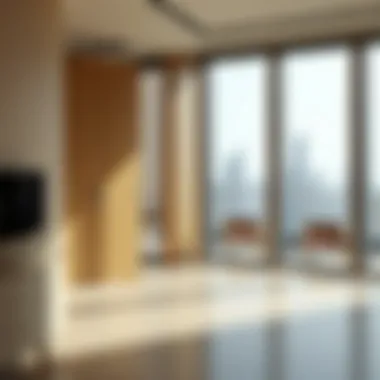
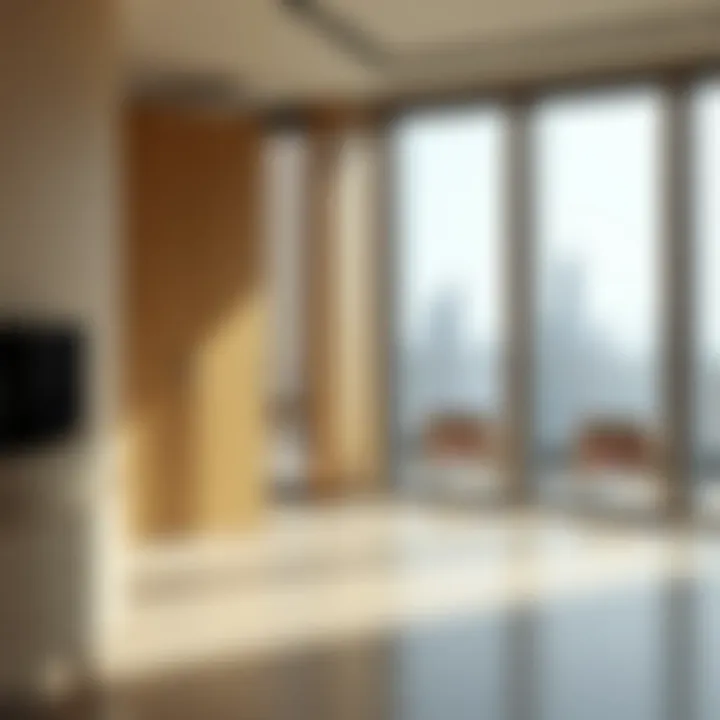
"A great tower is a symphony of design that resonates with every layer, especially in how it deals with the complexities of private and shared spaces."
This comparative analysis not only showcases the standout features of Al Safa Tower, but also provides benchmarks for architectual wisdom that can inform the construction of future towers across Dubai, enhancing overall living standards and urban experiences.
Future Trends in Partitioning
The future of partitioning in architectural designs is not just a fleeting trend; it’s a reflection of evolving living needs and technological advancements. This section zeroes in on the pivotal nature of partitioning systems in Al Safa Tower, considering how innovation paves the way for enhanced living spaces. As we go deeper into emerging technologies and market predictions, it becomes clear that partitioning influences not only aesthetics but also functionality and resident satisfaction.
Emerging Technologies in Partition Design
In the realm of modern architecture, technology is revolutionizing traditional approaches. Smart partitions are making headway, integrating features that boost convenience and personalization. For instance, movable wall systems allow residents to reconfigure spaces quickly and efficiently, adapting to varied uses from workout areas to entertainment lounges. This feature is especially valued in urban settings where space may be limited.
Moreover, advancements like acoustic-enhancing materials are being utilized to ensure privacy without sacrificing openness. Technologies encompass sound-absorbing panels that fit seamlessly into design aesthetics, creating a chic yet functional environment.
Some key elements to consider in this technology wave are:
- Automated Systems: Sensors can adjust partitions based on occupancy, ensuring optimal space usage.
- User-Friendly Interfaces: Homeowners can tailor their environments using apps that control partition settings, delivering a bespoke experience.
- Augmented Reality Previews: Prospective buyers can visualize potential layout changes through AR tools, enabling informed decisions.
This marriage of cutting-edge technology with partition design offers unparalleled flexibility and adaptability, appealing to discerning residents who seek functionality alongside elegance.
Predictions for Dubai's Real Estate Market
As we cast our eyes toward the horizon of Dubai’s real estate market, the signs point toward substantial growth fueled by innovative partition solutions. Developers, investors, and homeowners alike are keen on optimizing space without compromising on luxury. With high demand in urban living, the appetite for multi-purpose layouts is on the rise.
A few notable trends are likely to shape the market:
- Sustainability Focus: Real estate stakeholders are prioritizing eco-friendly materials in partition design, aligning with global trends for greener living.
- Luxury Experience: Residents increasingly seek homes that reflect personal tastes. Custom partition solutions will therefore become a pivotal selling point.
- Community-Oriented Designs: Developers may explore designs that encourage communal interactions, integrating shared spaces through strategic partitioning.
"Investing in adaptable spaces is investing in the future of living. As the dynamics of urban lifestyles change, so must our architectural responses."
Ending
The section on conclusions plays a pivotal role in wrapping up the extensive analysis provided throughout the article. In particular, it serves as a final opportunity to reflect on the key insights gleaned from exploring the partition systems in Al Safa Tower. One notable point is how the partitions enhance functionality while also contributing to aesthetic appeal.
Summarizing Key Insights
To summarize, the examination of Al Safa Tower's partitions has revealed several important elements:
- Functionality and Flow: The strategic placement of partitions not only determines the flow of the space but also maximizes its usability for residents.
- Aesthetic Harmony: The materials and design choices reflect a commitment to high-end living, blending luxury with practicality.
- Psychological Impact: The design decisions regarding partitions directly influence residents' well-being and sense of comfort within their homes.
These insights are vital for investors and homeowners looking for properties that offer both luxury and an optimized living environment.
The Role of Partitions in Future Developments
Looking ahead, the role of partitions in future developments cannot be overstated. With technology advancing rapidly, it’s likely that innovative materials will emerge that not only improve the partitioning process but also enhance environmental sustainability. For instance, smart partitions that adapt according to the time of day or activity within the space could redefine how people interact with their living environments.
Furthermore, as urban spaces continue to evolve, the emphasis on creating multifunctional layouts will become paramount. Developers and architects will need to consider how partitions can cater to the changing lifestyles of residents who demand flexible and adaptable spaces, while still ensuring privacy and comfort.
Cited Works
This section gathers all the academic and professional works cited throughout the article. It includes a variety of sources such as:
- Books: Texts on architectural principles and design innovations that provide context regarding partition systems.
- Peer-reviewed Journals: Articles that detail case studies and analyses concerning similar constructions, deepening the understanding of Al Safa Tower's unique elements. For instance, the Journal of Building Construction highlights studies on effective partitioning in urban high-rises.
- Thesis and Dissertations: Scholarly works from universities that explore modern architectural challenges and solutions relevant to contemporary construction practices.
- Online Resources: Websites offering insights into Dubai’s architectural framework and economic implications of luxury towers. Sources like en.wikipedia.org and britanica.com can provide factual background or historical context.
By referencing diverse and reputable sources, the article enhances its credibility and provides readers with a pathway for further exploration.
Further Reading
For those keen on delving deeper into the subject matter of partitions and their effects on architectural design, a curated list of additional readings is beneficial. Consider the following resources that may provide valuable perspectives:
- Books on Architecture: Titles such as "The Architecture of Happiness" by Alain de Botton which explores how design influences our emotions, particularly in living spaces.
- Industry Reports: Publications from real estate firms detailing current trends in high-rise buildings and the integration of partition systems.
- Online Blogs and Articles: Websites like reddit.com often feature discussions on personal experiences with residential living in towers and insights into their design.
- Government Publications: Insights from planning and zoning policies regarding urban development in Dubai, available on *.gov sites, help clarify regulatory frameworks impacting such structures.
These resources not only supplement the information presented in the article but also encourage a broader understanding of how partitions play a crucial role in urban architecture.

